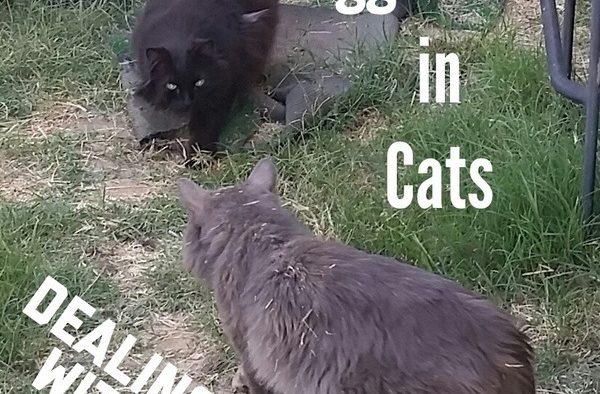Types of Aggression in Cats – Part 1
Share

 Whap! Snarl! Hiss! Chase! Scrabblescramble. Cry! STOP IT! ISAIDSTOPPIT!
Whap! Snarl! Hiss! Chase! Scrabblescramble. Cry! STOP IT! ISAIDSTOPPIT!
Who hasn’t been there? Anyone who hasn’t had more than one cat.
Aggression trails only soiling outside the box as the big behavior problem. And, until you figure out the type of aggression, it can be hard to stop it.
The good news: you can. There are several distinct kinds. Sure, it ends up the same way: someone gets hurt: you or another cat. However, the more you know about why the skirmish is happening, the better you can manage the situation. Several of the most common types include:
Redirected Aggression
This one’s easy to spot: cat is looking out the window, sees a bird or cat he can’t get at, reacts, you happen to be near, and he goes after you. Or he’s wanting to pick a fight with your other cat or dog, you intervene, and…you get it. Like when you hurt your elbow, then someone looks at you and you snarl, ‘What’re YOU looking at?’
It’s basically my version of a deflected “Gah!”
Suggestion: if cat is reacting to outside cats, block his view of other feline interlopers. Cardboard and foil taped to windows are ugly, true, so consider translucent sheeting that sticks on with static at DIY stores. If that isn’t enough or it isn’t practical, motion-sensor sprinkler attachments are humane and do the trick: Tom saunters by, and spritz! Next yard…

Petting Induced (Over-stimulation)
Your own fault, you know. Different cats have different thresholds for physical affection. Noodles does give a warning, when she’s had enough: watch her body language. The important word here is ‘beginning’: his body begins to tense, fur begins to ruffle, tail begins to switch, pupils begin to dilate, ears begin to flatten. Stop petting immediately. To lengthen the time she stays on your lap to be petted, give one more stroke, each time; if she stays, treat. Love through the stomach. As with men.

Pain Induced
’m not referring tot he obvious: a pulled tail or a foot accidentally stepping on her. I mean that you may not recognize a sore spot. Say, on the spine. Gracie hurt herself, or developed arthritis, and you didn’t know, and when you touch a part, she nips or scratches you. It’s a new response. When it’s the same place, a particular spot, see the vet. Handling a kit all over, frequently, might raise her threshold for pain-aggression, and certainly relaxes her during nail-trims.
Play Aggression
The difference between play-aggression and real fighting?
In play, claws aren’t out, there’s no or very little vocalizing, someone’s not running away, and both kids are taking time-out to reposition, re-pose themselves, before then next launch. When cats play-fight, they part easily, action’s over, and there is no residual tension in the air. Play-fighting is more than healthy, it’s how kits learn. How they find out this hard a bite means fun; that hard a bite means not good. How to capture prey. A way of judging the character of the Other Guy.
Intervene-not by picking up one of the kids, but by ‘breaking the script’; put a piece of cardboard, or even an album cover, between them, gently shoo one cat away to cool for no longer than 5-7 minutes.











